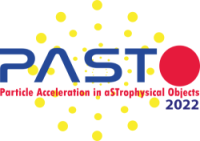Conveners
Theory of Particle Acceleration in Astrophysical Environments
- Giovanni Morlino (Istituto Nazionale di Astrofisica (INAF))
Theory of Particle Acceleration in Astrophysical Environments
- Giovanni Morlino (Istituto Nazionale di Astrofisica (INAF))
Theory of Particle Acceleration in Astrophysical Environments
- Frank Jenko
Cosmic rays are accelerated to a few PeV, and maybe 100PeV, in the Milky Way Galaxy. They are accelerated beyond 100EeV elsewhere. If I did not know better, I would say this could not happen, especially with such high efficiency. In this talk I discuss how acceleration to these energies pushes against the limits of theoretical credibility and how the underlying plasma physics has to be...
Cosmic rays that span many decades in energy are one of the main contributors to the non-thermal energies in the universe. Although the diffusive shock acceleration (DSA) is the promising mechanism for particle acceleration at shocks, whether or not the mechanisms that promote to the DSA act similarly for electrons and protons are still not well understood. Since the energy gained by a...
Magnetized turbulence and magnetic reconnection are often invoked to explain the generation of high energy particles in astrophysics. Originally, these two routes for particle acceleration were treated as distinct plasma processes. However, with the rapid advances in computing power and theory, they are converging towards a unified domain. In this talk, I will outline recent developments in...
Magnetic reconnection is a powerful acceleration mechanism since it can impulsively deliver energy that was accumulated for long times and in large volumes. The promptly available energy is stored in magnetic fields produced by current sheets, i.e. antiparallel fields at the two sides of the sheet, with a null in between.
The sudden onset of reconnection events poses the so-called *trigger...
Non-thermal acceleration is one of the most challenging problems in theoretical plasma astrophysics. There is an enormous number of astrophysical objects that emits powerful outbursts of high-energy radiation with non-thermal spectrum like Pulsar Wind Nebulae (PWNe), and Blazars. There is a strict relation between the emitting particle’s energy and the resulting photon energy. The ideal...
Supernova remnants (SNRs) are believed to produce the most part of the galactic cosmic rays (CRs). SNR non-relativistic collisionless shocks responsible for acceleration of CRs via diffusive shock acceleration. This process involves pre-existing mildly energetic particles, a means of pre-acceleration is required, especially for electrons. Electron injection remains one of the most troublesome...
A plasma outflow coming from the center of “Milk Way” Galaxy is simulated by an ion “beam” reaching a nearly stationary magnetic field “arch” with dimensions of the same order of magnitude as that of the Galaxy [1]. Then waves can be excited efficiently in the rarefied plasma (10-2-10-4 cm-3) permeating the relevant magnetic field configuration. These are electrostatic “Lower Hybrid” modes...
Cosmic ray driven instabilities play a crucial role during particle acceleration at shocks and during the propagation of the accelerated cosmic rays in astrophysical systems. The instabilities amplify magnetic fields and modulate cosmic ray transport so that the intrinsically collisionless cosmic ray population is coupled to the thermal plasma and provides important dynamical feedback. We...

